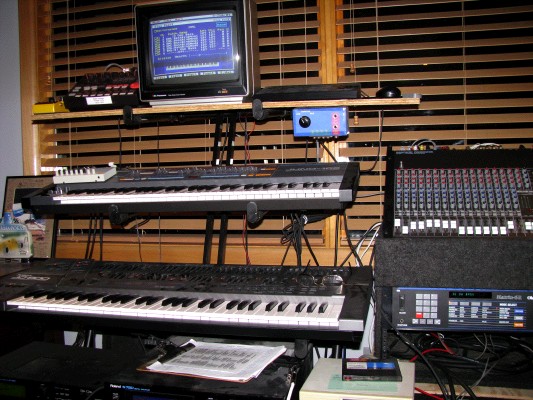
Photo 1:

This is the top part of my main keyboard stand. The stand itself is a triple-deck QuikLock. The two keyboards visible in the center and lower decks are a Roland Juno-106 (upper) and a Roland JD-800 (lower). The JD-800 serves as the master keyboard in my setup. To the right is a small road case containing a Mackie CR-1604 mixer and an Oberheim Matrix-6R synth. A Midiman 12x2 submixer sits on top of the 106; it submixes the JD-800 and JD-990 main outs.
The top deck shelf is made from a piece of 1/2-inch oriented strand board, left over from a roofing job. On the shelf are (left to right): a Boss DR-202 drum machine, an old Panasonic monitor which is the display for the Roland sampler (shown in the next photo), and the RC-100 remote controller for the sampler. (I used to have a Fostex X28 four-track cassette recorder up here, which I used as my main mixer, but it has now been retired.) The little yellow box to the left of the drum machine is an old DoD FX50 fuzz box.
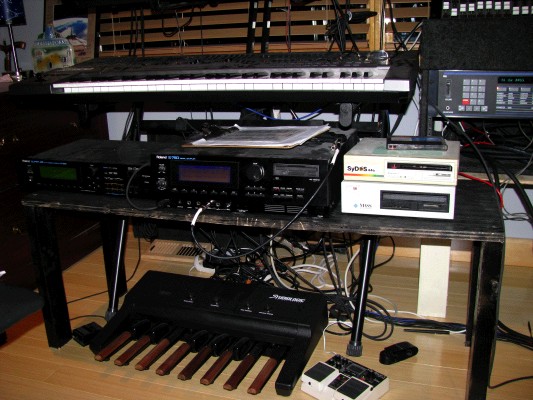
The underside of the keyboard stand. At top is the JD-800. Underneath is a bench that I built which fits over and around the front legs of the stand. From left to righg on the bench are a Roland JD-990 synth, a Roland S750 sampler (the RC-100 and mouse in the previous photo connect to this), and two Syquest removable-cartridge drives for the sampler. Underneath the bench is a Studiologic MP-113 bass pedal set. To its left is a sustain pedal for the JD-800; to its right is a Boss Giga Delay. The top of the sampler serves as the resting place for a clipboard of patch charts and cheat sheets.
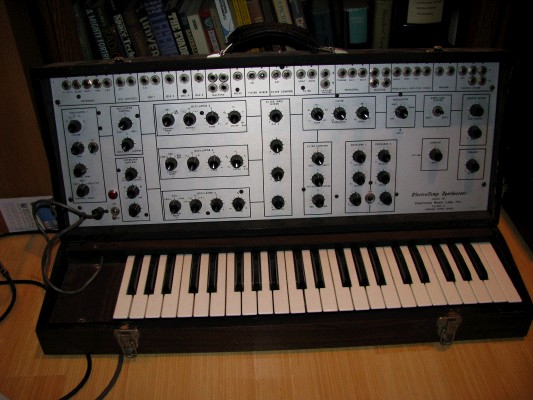
This is an EML Electrocomp 101, serial number 0708. (From that serial number, and the presence of some features that were adapted during the production run, I figure that it was probably manufactured around 1977.) It is shown with the keyboard plugged in, but about half of the time I remote-contol it with the JKJ Electronics CV-5 MIDI-to-CV converter, (not shown).
Not pictured is a Hammond A100 organ, which currently resides in the garage because I haven't got space for it in the room. I bought it in 2001 from a furniture restoration shop in Scottsboro, AL. The priorprietor gave me a good deal on it -- with the provision that it be removed from the premises that afternoon, a feat that anyone who has ever owned a Hammond tonewheel organ knows is much easier said than done. I had to borrow a friend's pickup truck, in addition to borrowing him. It's quite possible that I have one less friend now. The organ was in surprisingly good shape when I bought it. The proprietor told me that he had bought it at an estate sale and was going to give it to a teenage granddaughter, but she wasn't interested in it. Her loss. The estate he bought it from may have been the original owner, judging from the condition of the cabinetry, the fact that a barely-used tube of Hammond oil was still taped to the expression pedal box, and the fact that, well, it was in Scottsboro. I've had some trouble dating it, but I think it was built in 1964. Apparently it had not been played in some time when I acquired it; all of the oiling pads were dry, and the keyboard contacts and drawbars were gravelly. However, I got it oiled and fired it up and started playing, and the noisy contacts cleared up quickly. It's in good shape; it plays nicely except for a couple of individual tones that are a bit weak. The vibrato scanner works perfectly. It still has the original wax capacitors in the generator filter circuits, and I am loath to mess with them regardless of all the advice on the net about re-capping. As long as it works, and sounds good, why mess with it? The only little problem it has is that sometimes the start motor doesn't engage. I put some oil on it and it got better, but there are still times when it has to be nudged with a pencil.
Also not pictured are my guitars and basses. I'm a fairly decent bass player and a mediocre guitar player. Back in 1992, I came across a Fender Squire P-Bass at a pawn shop at a good price. My brother Drew then gave me some EMG active pickups as a birthday present, and that is the configuration it remains in today. My second bass is a Kramer Duke, which is an '80s headless bass with an aluminum neck. I always liked the sound that Kansas' bassist Dave Hope got with the Kramer aluminum basses, and when I came across this one on E-bay in 2003, it was a done deal. I use Rotosound round-wound strings on both of the basses. My guitar is an Aria RS Strat copy, with wang bar. I bought it off of a guy in Ft. Lauderdale in 1987. It was a nice-playing guitar when I bought it, but when I lived in New Jersey in 1988, something about the weather there caused the neck to warp, and it's never been quite the same since. Nonetheless, it's still a decent guitar (except for the plastic nut, which is all chewed up and is going to get replaced as soon as I get annoyed enought to do it). I use light-gauge GHS Boomers on the guitar. I've got two guitar amps: a Music Man HD110 (basically that company's version of the Fender Twin Reverb), and a little solid-state Fender Sidekick. I've been using the HD110 as a live amp for informal gigs at friends' houses, but it isn't really suitable for bass or keyboards, and it may wind up sold. The Sidekick is a handy practice amp, but it tends to get used more as a recording effect. (A song I haven't finished yet will have a drum track run through it.) On those rare occasions when I record guitar or bass, I tend to take them direct.

This is the "Discombobulator" modular synthesizer. My concept of a modular is that it will be composed of a number of "function blocks" containing modules to perform a certain set of functions. Each function block has its own power supply, so that the blocks can be moved around as needed. It's been reconfigured several times; the photo above is as of 31 December, 2007. Block 2 is at the top of the stack (it has to be because I haven't gotten around to adding a top to it yet), with Block 1 in the middle an Block 3 at the bottom.
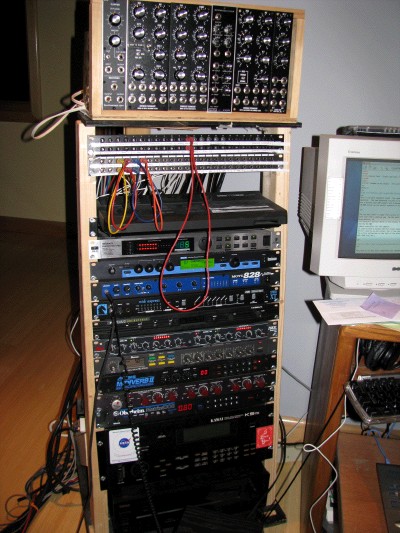
Here's my DIY 19-inch rack (with block 2 of the Discombobulator sitting on top). The rack rails and supporting struts (the struts are not visible in the photo) are made from 2x4 dimensional lumber. The rails aren't pre-drilled; I drill a hole wherever I need to mount something. Everything is mounted with about a 3/8" gap between modules to improve ventilation. The platform is 5/8" plywood, and the whole rig rolls on four 3-inch casters. The top shelf is 3/8" plywood.
The mounted equipment, from the top, consists of:
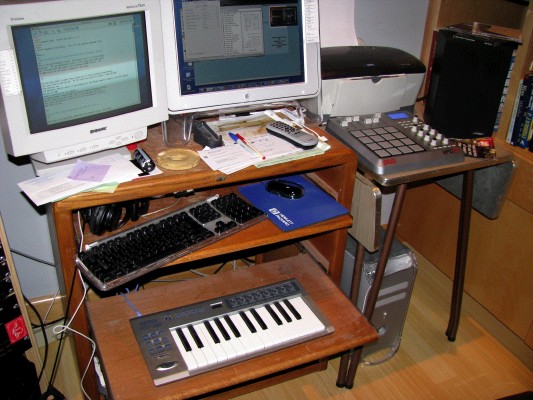
My computer is a Macintosh G4 1 MHz dual processor. The sequencer software is Sagan Technology's Metro, version 6.3.8.6 as of this writing. I've been using various version of this software since 1992, and I've never found anything else that seemed as comfortable. I've gone totally to hard disk recording, and I use Metro for both MIDI and audio. An Edirol PCR-1 USB keyboard sits on the shelf under the alpha keyboard. I use the mini keyboard mainly for patch editing and auditioning; it saves me the trouble of stepping away from the computer to play the JD-800's keyboard when I'm building patches for the rackmount synths or the soft synths. As a performance keyboard, it's not that great. On the table to the right is an Akai MPD-24 drum pad and knob box.